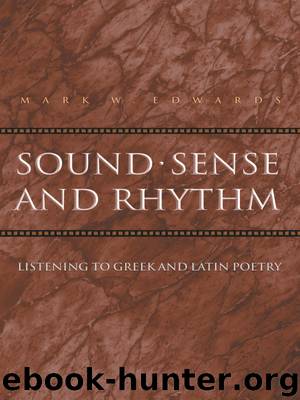Sound, Sense, and Rhythm by Edwards Mark W

Author:Edwards, Mark W.
Language: eng
Format: epub
Publisher: Princeton University Press
Published: 2008-01-30T16:00:00+00:00
Dale (1983: 185) agrees with this; other editors vary. Because all modern editors combine some of the cola separated by earlier editors, but keep the traditional line numbers, a line number is occasionally omitted in my translation (as in Murray’s text).
71 Line 770 is iambic metron + choriamb + bacchiac; 771 is choriamb 1 bacchiac.
72 Printed by Murray:
73 The text is mangled.
74 See Prins 1991: 186–192: “Paeons are in fact associated with throughout the Oresteia” (189).
75 See also Rosenmeyer 1982: 34–35.
76 Attributed by F. S. Edwards to the late Lionel Pearson.
77 Contra, Scott 1984: 82: “Because they are a dour, gloomy chorus, the lack of any variation in their meter is quite consistent with their characterization.”
78 Analysis in ibid.: 83.
79 In the dialogue portions of the Agamemnon, there is a dramatic metrical effect as the king’s death cries from within the palace interrupt the chorus, which is chanting anapaests and (we think) preparing for another lyric song. In this passage (mercilessly parodied in Housman’s Fragment of a Greek Tragedy, though he ignores the change in meter) Agamemnon utters a verse in the usual iambics of dialogue (1343); the astounded chorus (or perhaps just the chorus leader) responds in the other meter of dialogue, the swifter and livelier trochaic tetrameter; Agamemnon cries out again; and the chorus (or its leader) speaks a further two tetrameters, before splitting up and speaking individually in twelve separate iambic couplets as the chorusmen express (visually as well as in speech) their disunity and perplexity (1348–1371). Later, as the discourse between Aegisthus and the chorus threatens to become violent (1649ff.), both parties switch from iambics to trochaic tetrameters until the end of the play. Aeschylus elsewhere uses such tetrameters only in his Persians, in dialogues between Atossa and the chorus and Atossa and the ghost of Darius. In Euripides’ Bacchae, tetrameters are used when the disguised Dionysus describes to the chorus what happened when he was imprisoned inside the palace (Bacchae 604–641; see E. R. Dodds’ note ad loc. in his commentary [Oxford, 1944]).
80 Some familiarity with recent poems in English, by well-known poets, that have made use of ancient models should make it easier to comprehend the rhythms of the originals in both choral and solo lyrics, and accordingly some examples are discussed in Appendix D.
Download
This site does not store any files on its server. We only index and link to content provided by other sites. Please contact the content providers to delete copyright contents if any and email us, we'll remove relevant links or contents immediately.
| Ancient & Classical | Arthurian Romance |
| Beat Generation | Feminist |
| Gothic & Romantic | LGBT |
| Medieval | Modern |
| Modernism | Postmodernism |
| Renaissance | Shakespeare |
| Surrealism | Victorian |
4 3 2 1: A Novel by Paul Auster(11788)
The handmaid's tale by Margaret Atwood(7448)
Giovanni's Room by James Baldwin(6808)
Asking the Right Questions: A Guide to Critical Thinking by M. Neil Browne & Stuart M. Keeley(5356)
Big Magic: Creative Living Beyond Fear by Elizabeth Gilbert(5352)
Ego Is the Enemy by Ryan Holiday(4957)
On Writing A Memoir of the Craft by Stephen King(4662)
The Body: A Guide for Occupants by Bill Bryson(4583)
Ken Follett - World without end by Ken Follett(4443)
Bluets by Maggie Nelson(4261)
Adulting by Kelly Williams Brown(4232)
Eat That Frog! by Brian Tracy(4149)
Guilty Pleasures by Laurell K Hamilton(4116)
White Noise - A Novel by Don DeLillo(3829)
The Poetry of Pablo Neruda by Pablo Neruda(3815)
Fingerprints of the Gods by Graham Hancock(3738)
Alive: The Story of the Andes Survivors by Piers Paul Read(3730)
The Book of Joy by Dalai Lama(3697)
The Bookshop by Penelope Fitzgerald(3619)
